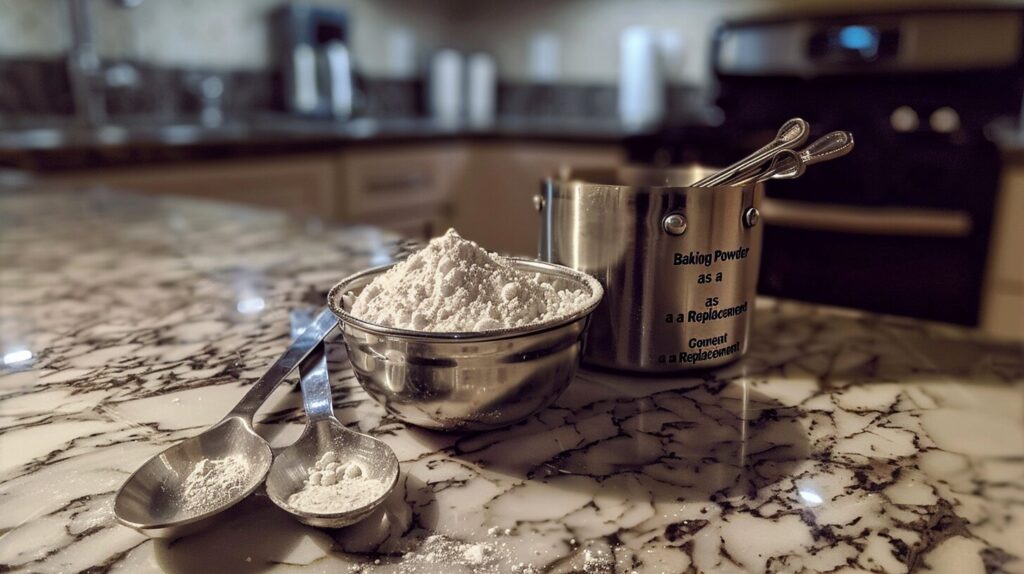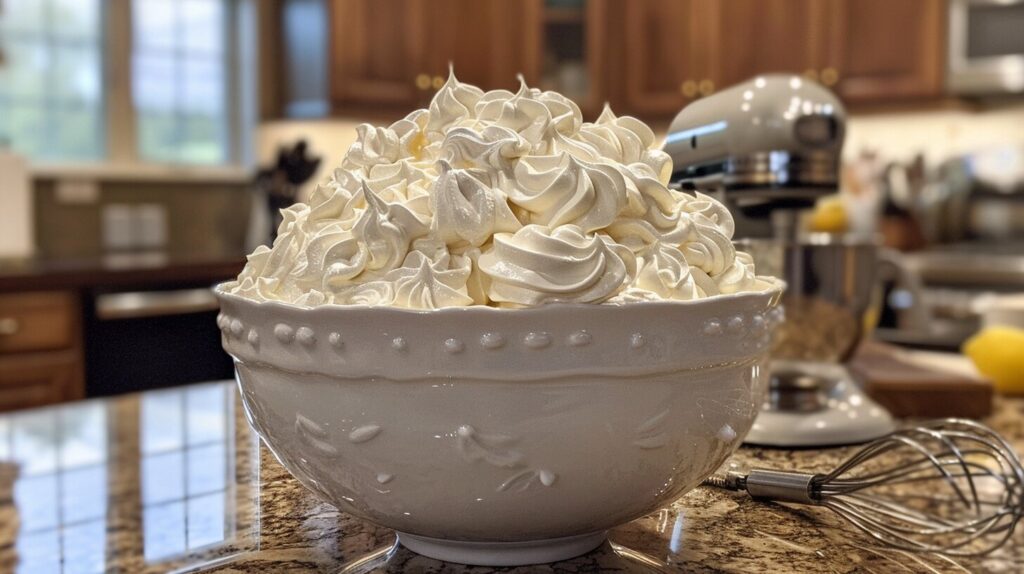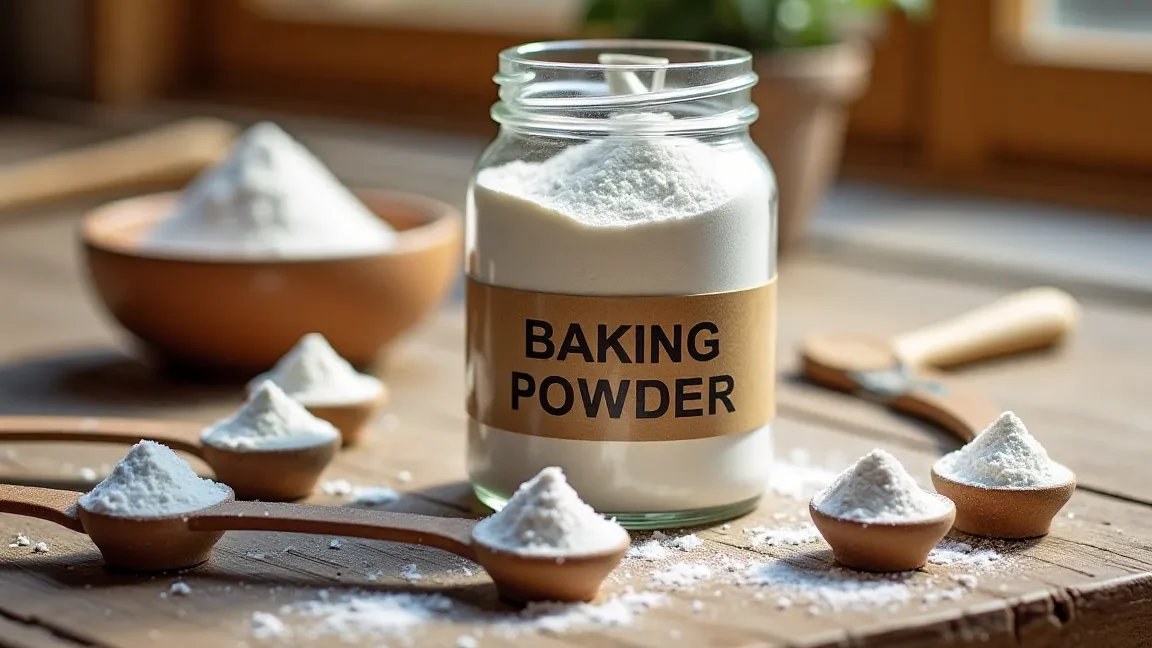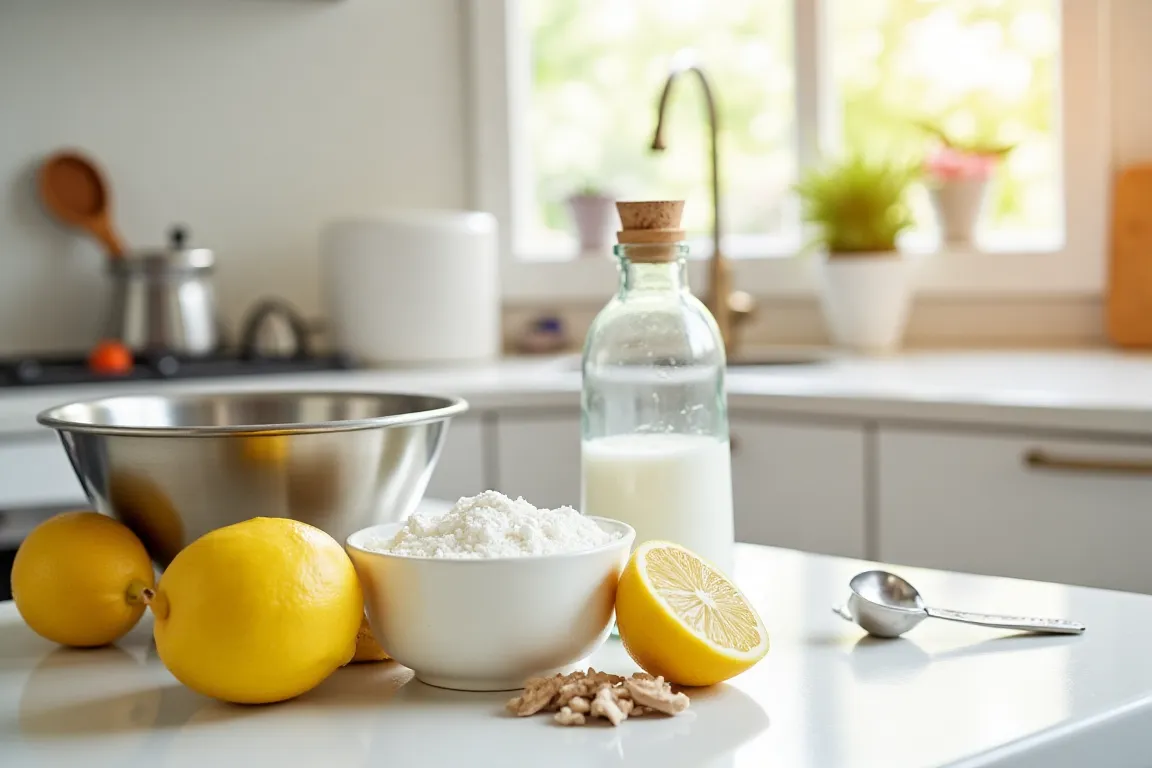This guide explores baking soda substitutes, explaining what is Replacement for baking soda and cooking and what ingredients can effectively replace it in different recipes. We’ll cover why substitutions might be needed and how to adjust recipes accordingly.
Table of Contents
Understanding Baking Soda’s Role in Baking
Leavening Agent
Baking soda is a leavening agent. This means it helps baked goods rise and become light and fluffy by creating tiny air bubbles inside the batter or dough.
Chemical Reaction
Baking soda is a base. When you combine it with acidic ingredients, like vinegar or lemon juice, a chemical reaction produces carbon dioxide gas. The gas is absorbed into the batter, creating bubbles. These bubbles make cakes, cookies, and other baked goods rise.
Fluffy Results
The amount of baking soda you use affects how much your baked goods rise. Too little, and they might be flat. Too much, and they can taste bitter. Recipes carefully balance baking soda with acidic ingredients for the perfect rise and flavor.

Why You Might Need a Baking Soda Substitute
Sometimes, you might need to use something else instead of baking soda. Here are a few reasons why:
Allergies
Some people are allergic to baking soda. If you’re one of them, you’ll need a substitute to enjoy your favorite baked goods.
Supply Issues
You might be out of baking soda. This is a common reason for needing a replacement.
Flavor Changes
Baking soda has a slightly salty, bitter taste. Some recipes need a different flavor profile, and a substitute can help achieve that. For example, some recipes call for a more subtle leavening effect and less of that distinct baking soda flavor.
Best Baking Soda Substitutes: A Detailed Comparison
Baking Powder
Baking powder already contains an acid. It works similarly to baking soda, but you’ll need more. For every teaspoon of baking soda, use 3 teaspoons of baking powder. The taste might be slightly different.
Potassium Bicarbonate
Potassium bicarbonate is a chemical relative to baking soda. You can use it in a 1:1 ratio. It might slightly affect the final product’s color.
Acid and Base Combinations
Mixing an acid (like lemon juice or vinegar) with a base (like baking soda) creates the same chemical reaction that makes baked goods rise. The exact amounts depend on the acid’s strength and the recipe. To get good results, experiment and carefully follow recipes that use this method.
| Ingredient | Quantity (per teaspoon of baking soda) | Note |
|---|---|---|
| Baking Powder | 3 teaspoons | May slightly alter taste. |
| Potassium Bicarbonate | 1 teaspoon | May slightly change color. |
| Acid + Base Combination | Varies; recipe-dependent | Requires careful measurement and recipe adjustments. |
Using Replacement for baking soda

Baking Powder: A Simple Swap
Baking powder already has an acid and a base, which means it can make baked goods rise like baking soda. However, you need more baking powder. Use about three times as much as you would baking soda.
Recipe Adjustments with Baking Powder
The exact amount of baking powder depends on your recipe. Some recipes might need a little more or less. Using baking powder instead of baking soda might result in a slightly different taste. Always check the recipe for guidance.
Substituting with Potassium Bicarbonate
Potassium Bicarbonate: A Baking Soda Twin
Potassium bicarbonate acts like baking soda. It helps baked goods rise by creating bubbles of carbon dioxide gas, similar to how baking soda works with acids.
Using Potassium Bicarbonate in Recipes
You can swap potassium bicarbonate for baking soda using the same amount. For example, if a recipe calls for 1 teaspoon of baking soda, use 1 teaspoon of potassium bicarbonate.
Taste Test is Key
Potassium bicarbonate can have a slightly salty taste. Before using it in a whole recipe, make a small test batch. This lets you check the taste and ensure it works well in your recipe. Adjust the amount or add other ingredients to balance the flavor.
Acid-Base Combinations as a Baking Soda Replacement
Making Baking Soda’s Reaction
You can replace baking soda by mixing an acid and a base. Baking soda is a base. Acids like lemon juice or vinegar react with it, creating carbon dioxide gas, which makes baked goods rise. This works similarly to how baking soda alone works in recipes with acidic ingredients.
Recipe Changes for Acid-Base Substitutions
The amounts of acid and base you need change depending on your recipe. A stronger acid needs less base. Recipes using this method often require careful measuring and adjustments. You should experiment to find the right amounts for a good result. Start with a small test batch to check how it tastes and rises before making the full recipe.
Recipe Adjustments for Substitutions

Careful Measurements
When you replace an ingredient, follow the instructions closely. Using the correct amount is very important. You should change the amount of liquid in your recipe to get the right texture. For example, if you use baking powder instead of baking soda, you’ll need three times as much. Too little baking powder will flatten your baked goods, and too much can taste bitter.
Liquid Adjustments
Different substitutes can affect how wet or dry your batter or dough is. Baking powder absorbs more liquid than baking soda, so you may need to add more liquid to maintain consistency. If you’re using potassium bicarbonate, you might not need to change anything, but always check the texture.
Taste Testing
Before you bake a whole batch, make a small test. This lets you taste the result and see if you need to add anything else. If it tastes too salty, add a little more sugar. Adding more or less liquid might help if the texture is off. Taste tests help you avoid problems with the entire batch.
Ingredient Interactions
Remember that ingredients affect each other. Substituting one ingredient might change how different ingredients work together. For example, if you use lemon juice instead of vinegar, you might need to adjust the amount of base you add to get the proper rise. Experimenting carefully is part of finding the perfect recipe.
Troubleshooting Common Issues with Substitutions
Flat Baked Goods
If your cakes or cookies are flat, you may not have used enough leavening. Baking powder and potassium bicarbonate work differently than baking soda. Make sure you’ve used the correct amount based on the conversion chart. Recipes using acid-base combinations require careful measuring to produce enough carbon dioxide for a good rise. check out this guide.
Off Flavors
A substitute might change the taste of your baked goods. Baking powder can sometimes taste slightly different than baking soda, and potassium bicarbonate might add a bit of saltiness. If you use an acid-base combination, the flavor will depend on your choices. A small test batch helps you check for off flavors before baking the whole recipe.
Experimentation is Key
Baking is a science. The best way to find the perfect substitution is to experiment. Start by following the substitution ratios we’ve provided, but don’t be afraid to adjust slightly. Pay close attention to your batter’s consistency and the final product’s texture and taste. Keep notes on what works best for you and your recipes.
Frequently Asked Questions
Why does my recipe need baking soda?
Baking soda helps baked goods rise by creating tiny carbon dioxide gas bubbles. This happens when baking soda, a base, reacts with acidic ingredients in your recipe.
What if I’m allergic to baking soda?
You can use baking powder, potassium bicarbonate, or a combination of an acid (like lemon juice or vinegar) and a base (like another baking soda substitute) as a substitute. Remember to adjust amounts based on the specific substitute you choose.
Do I have to use baking powder in place in baking soda?
Yes, but you’ll need three times as much baking powder as the recipe calls for baking soda. Baking powder contains an acid, producing the necessary gas to rise differently than baking soda. The taste may be different.
How do I substitute baking soda with an acid and base?
Carefully follow a recipe that uses this method. The amounts of acid and base needed will depend on the recipe and the strength of the acid you choose (e.g., lemon juice or vinegar). Experimentation is key, so start with a small test batch.
Is potassium bicarbonate a good baking soda substitute?
Yes, it’s chemically similar, and you can usually use it in a 1:1 ratio. However, it might add a slightly salty taste, so a taste test is recommended.
What if my baked goods are flat after using a substitute?
You may not have used enough leavening. Double-check your measurements based on the conversion guide provided in the article. Insufficient acid in the recipe when baking soda is used may also cause this issue.
What should I do if my baked goods taste off?
A substitute might have slightly altered the flavor. Baking powder can taste differently than baking soda, while potassium bicarbonate might make things somewhat salty. Using an acid-base combination might also introduce a distinct flavor. Start with a small test batch to check the taste before committing to the entire recipe.
Conclusion: Choosing the Right Baking Soda Substitute
Successful Baking with Substitutions
Replacing baking soda means understanding its role in baking. When mixed with acidic ingredients, it helps baked goods rise by creating carbon dioxide gas. Substitutes like baking powder, potassium bicarbonate, or acid-base combinations can work but require careful adjustments.
Important Considerations for Success
Remember, different substitutes have different properties. Baking powder needs a 3:1 ratio compared to baking soda. Potassium bicarbonate works similarly but might add a slightly salty taste. Acid-base combinations require precise measurements to get the proper rise. Always check the recipe and do small test batches to avoid issues. Careful measuring and taste testing are key to success.
Recipe Adjustments: The Final Step
Depending on the substitute used, adjusting liquid amounts might be needed. Baking powder absorbs more liquid than baking soda. Taste testing helps you catch flavor imbalances early on. Keep notes on your experiments to refine your baking skills. Replacing baking soda requires understanding how it works in recipes. Use this guide to choose the best substitute and adjust your recipes for success.
